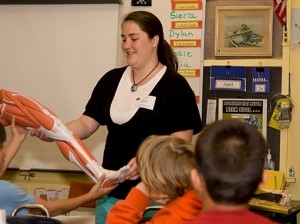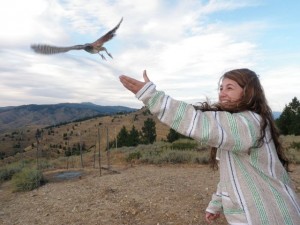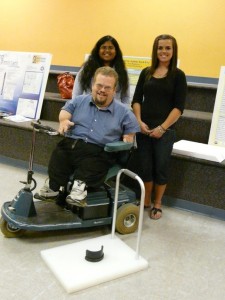Examples of SL in STEM
Below are examples of past Service-Learning STEM courses, including their community partners and project details. These can be used as a starting point for planning your own STEM Service-Learning course.

Types of service-learning in STEM*
Student extend their learning through participation in…
1. Educational Outreach
Teaching, mentoring, demonstrating, or presenting their knowledge and/or skills with a community partner. Current partnerships include:
- 4-H Afterschool Programs
- Central District Health
2. Field Experience
Designing experiments and collecting data, or contribute to ongoing scientific studies through monitoring of data for a community partner. Current partnerships include:
- Department of Environmental Quality
- Idaho Rivers United
- Foothills Learning Center
- IdahoWatch
3. Design and Production
Applying technical skills to design and/or produce a product for community partners. Current partnerships include:
- Schools (design produce adaptive devices)
- Village Bicycle Project (design low tech devices for developing countries)
- Boise Bicycle Project (repair bikes for low-income families)
4. Community Planning
Consulting, planning and/or designing community related structures and programs. Current partnerships include:
- Department of Environmental Quality (identify sources of nitrate loading in ground water and evaluating water use conservation practices)
- Boise Parks and Recreation (draft a plan to improve signage and wayfinding for pedestrians and bicyclists)
5. Background Research
Conduct needs assessment and/or background research on current issues for community organizations. Student may then work with community partner to disseminate to the public.
6. Community Outreach and Impact
Assist community advocates in raising awareness of issues, such as participating in outreach events, citizen science, writing newsletter articles, developing YouTube videos, etc. Current Partnerships include:
- St. Lukes Vaccination Program
- American Kestrel Project (citizen science)
STEM Course Ideas
- SENCER.NET Science Education for New Civic Engagements and Responsibility
- Discipline specific syllabi from Campus Compact
Examples of Boise State STEM Service-Learning classes & projects
BIOL 444/544- Vaccines and Vaccine Development – Dr. Julie Tinker
Description: Students participated in one of three community health projects through a partnership with the Central District Health Department Immunization Advisory Board (CDIAB) and The Idaho Immunization Program. These projects included: 1) working directly with Andy Nobel (Idaho Immunization Program) to update and validate vaccination records throughout the state; 2) working with members of the Immunization Board to coordinate and staff immunization clinics within Boise and the surrounding area; and 3) working with the Immunization Board to visit child care centers within Boise and surrounding area to promote vaccine compliance, knowledge and appreciation for this important target population. The students’ final project involved the development and upkeep of a Facebook site for the propagation and dissemination of vaccine information.
Dr. Tinker’s goal was to develop in her students an appreciation for the importance of public support, awareness and knowledge of vaccines and vaccine safety.
BIOL 605- Applied Raptor Biology – Greg Kaltenecker

Description: Students led and assisted group outreach tours for the Idaho Bird Observatory to visiting groups and K-12 classes. Students were able to provide a unique conservation perspective to visiting groups by communicating and interpreting raptor-related science and conservation to the general public.
Greg Kaltenecker’s goal was for his students to learn the importance of communicating science and research findings to the general public.
CHEM 432 – Biochemistry Lab – Dr. Ken Cornell
Description: Students examined bacterial samples for multidrug resistance for the Idaho Bureau of Laboratories. Activities confirmed some prior findings by the Idaho Bureau of Laboratories, and extend the observations to additional resistance phenotypes. Samples were analyzed through the spring of 2011, with a critical evaluation of the potential underlying biochemical mechanisms of the antibiotic resistance and its spread in the community. Outreach activities included student-led demonstrations at Boise-area High School science classes.
Dr. Cornell’s goals for his students included: 1) sharpened research and lab skills; 2) improved collaboration and oral presentation skills; and 3) development of writing skills important for scientific reports and publications.

ENGR 130- Introduction to Engineering – Carol Sevier
Description: Student teams were assigned to carefully selected projects of appropriate technical depth and duration that served a community need. Projects selected required teams to design, analyze, and implement the development of a new, adapted, or modified assistive technology solution for an identified individual’s unique need.
Carol Sevier’s goals were to increase students’ motivation in pursuing engineering careers, engagement in real world problems, and internalization of the impact that engineers can have in improving people’s lives.
ITM 490 – Senior Project: Practice of Information Technology – Dr. Robert Anson
Description: Senior capstone student teams developed a real-world information systems project for an identified community organization. The projects ranged from design and development a new information system, analysis and development of a prototype for a new system, to analysis of an organizations requirements and product identification of options for a compatible packaged system. Students were exposed to applied project management methodologies, requirements analysis, system design, programming languages, database, and networking.
Dr. Anson’s goal was for his students to gain experience in the design and develop of a complete systems project for a real-world client, from planning through implementation in a team-development environment.
ENVSTD 121- Introduction to Environmental Studies – Dr. Christopher Hill
Description: Students worked with a local environmental or conservation organization throughout the semester. Students used their experiences to provide insightful written reflection to problems posed in class and participation in class discussions. Guest speakers and community projects were also implemented as an integral part of the learning experience. Participating organizations include: Boise Urban Garden School (B.U.G.S), Boise Water Shed Environmental Education Center, USDA Agriculture Research Service Northwest Watershed Research Center, Growing Change Inc.
Dr. Hill’s goal was to develop in his students an integrated lens of scientific, socio-political, and humanistic approaches to the understanding of nature and of how humans interact with nature.